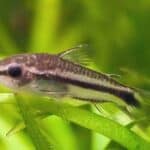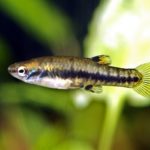The Pygmy Cory or Pygmy Catfish, is a freshwater fish that many enjoy to keep in their tanks. The Pygmy Corydoras is a schooling fish that will be the right choice for any community tank.
If you’re looking for a species of fish that is tiny, fun, cute and simple to maintain, then Pygmy Corydoras will be perfect for you! Read on to find out how to care for these pint-sized tank mates.

Species Summary
The Pygmy Cory, or Corydoras pygmaeus, is also referred to as the Pygmy Catfish, which is a freshwater fish from the Corydoradinae family. They are a small, peaceful species of fish that are well suited to freshwater tanks and aquariums.
Pygmy Corydoras are a species of freshwater fish that originated in the rivers of South America, and can be found in places such as the Aguarico River, and the Madeira River.
The Pygmy Cory is native to small creeks, pools and small tributaries and can be found in large groups together. The Pygmy Cory Catfish is a very small tropical fish indeed, making it the perfect addition to your aquarium, particularly if you are interested in nano fish!
As their name suggests, they are tiny sized fish, and therefore don’t need a lot of room, and can do well in decor filled tanks for a pleasing to the eye aquarium. This could be why they are so popular among aquarists!
Care Guide
To know more about the Pygmy Corydoras, and how to look after them, check out this Care Guide section!
Tank Size
Due to their small size, you do not need a very big tank to keep Pygmy Corys. You can even keep Pygmy Corydoras in a tank of just 10 gallons for a smaller group, but you may want to size up if you have a lot of them, or if you want to have a community tank.
However, you should keep in mind that the Pygmy Cory will prefer to have lateral swimming space, and will be very active and outgoing, so it may be worth purchasing a tank that is longer rather than taller.
You should also be aware that these fish are incredibly small, and so you may have to alter your filtration system, or block larger tubes with sponges to prevent any fish becoming lodged or stuck.
Tank Mates
In general, Pygmy Corydoras are known to be very peaceful creatures, and can therefore be kept with a variety of different fish, cohabiting very peacefully. Some of the best tank mates for Pygmy Corydoras are Neon Tetras, Ember Tetras, Hatchetfish, Mollyfish, Guppies, Dwarf Gourami, Zebra Danio, Cherry Barb and many more.
If you are planning on keeping the Pygmy Corydoras with others as part of a community tank, then you are best off keeping them with similar fish of a peaceful nature, and small size.
Same Species Tanks
As with many species of fish, Pygmy Corys will do best with other Pygmy Corys. They love to be in shoaling groups and are schooling fish in the wild. Therefore, if keeping them in an aquarium in captivity, they are best off being purchased in groups of at least 8.
This means that they can stay as a group and will not become lonely or stressed out. When in a larger group, they are very social creatures, and will love to play and explore in the tank.
Water Parameters
Just the same as many other freshwater fish, Pygmy Corys require living conditions that imitate their natural habitat. Therefore, you will have to keep the water conditions similar to the rivers of South America. What this means is that you will need to keep the waters fairly warm, with lots of living vegetation just like in the wild.
The only issue that you may have with Pygmy Corys is that they have specific water parameters that you need to maintain. For instance, they have a small range when it comes to comfort, so you need to ensure the water levels are just right.
For Pygmy Corys, you will have to keep the water temperature at about 72 degrees and 79 degrees fahrenheit. You will also have to maintain a pH level of 6.5 to 7.5, and a water hardness level of 6 to 10 dKH.
Due to their sensitive nature, you should regularly test the water in your aquarium to ensure that the Pygmy Corys are comfortable, and not under any stress due to their environment.
What To Put In Their Tank
Similar to most other freshwater fish, Pygmy Corydoras will thrive when they are kept in an environment that simulates their natural habitat. What this means is that Pygmy Corys will do much better when their tanks are decorated and filled with everything that they enjoy in the wild.
You may want to start with a soft substrate such as fine sand for the bottom of the tank, as Pygmy Corydoras do enjoy burrowing at the base and lower parts of the tank. To ensure that they do not injure themselves, you should avoid using rocks or gravel, and use a soft substrate.
These fish naturally survive in rivers, so a sand substrate is best as it replicates the river bed.
You will also need to add some vegetation and plants, as the Pygmy Corys will love to hide among any plants that they can find in freshwaters and riverbeds.
The good news is that you can have some variation in the plants, with floating plants and tall background plants to choose from. Mix it up and have a few different ones to keep your Pygmy Corydoras happy.
In addition to this, Pygmy Corydoras will love being in decorated tanks because this means that they have lots of places to hide, and things to explore, which keeps them mentally and physically stimulated at all times.
Common Diseases
In the same way as other freshwater fish, Pygmy Corys can be prone to diseases and illnesses such as Ich. That being said, these fish are known to be more prone to something called red blotch disease, which creates awful, bloody sores on the body.
This disease is often caused by stress, or due to unstable water conditions and an unsuitable environment. To ensure that your fish remain healthier for longer, and to prolong their lives, you should always stay on top of regular cleaning and maintenance of the tank, ensuring that the water temperature is just right for the species.
This can reduce the risk of illnesses and health problems developing, whilst also ensuring that the aquarium and fish are in the best condition.
Food & Diet
Pygmy Corydoras are known for their love of algae. These little guys will spend a lot of time nibbling and gnawing on algae and plants that they can get their fins on. However, they are omnivores, so will require some protein rich foods in their diet.
You can feed Pygmy Corys things such as high quality pellet and flake foods, but they will also enjoy brine shrimp, bloodworms, algae wafers and mosquito larvae, too. The key to keeping this species of fish healthy and thriving is a balanced diet, so make sure that you incorporate both when feeding.
Another vital piece of information we can give you is to never give them large pieces of food. As they are such small fish, they require smaller pieces and bites of food to consume and digest them properly.
Lifespan
For the most part, the average lifespan of Pygmy Corydoras is about three years. However, this can sometimes be shorter depending on the level of care that you give. Some can survive for about three years, as long as they have the right habitat, diet and water conditions.
Appearance
Pygmy Corydoras are one of the tiniest species of fish known to man. Due to their small size, they can often be mistaken for other breeds of fish, so we can help you distinguish these from the rest.
In appearance, the Pygmy Cory tends to have a larger head, and gets smaller as you go closer to the rear. This is called a tear drop shaped body, as it starts off big, and gets smaller. They tend to have under-turned mouths, with thick black stripes heading all the way from head to the caudal fin.
Despite being rather plain in color, they are very shimmery, and tend to have a silver, gray or white sheen to them that contrasts the black stripes along the side.
Size
This won’t come as a surprise to you, but the Pygmy Cory is actually very small and a teeny tiny species of fish. The average size of a Pygmy Corydoras is just about 1 inch in length. Some can grow slightly larger with the right care, but this is not often the case.
Behavior & Temperament
Pygmy Corydoras are generally one of the most peaceful species of fish around. They are not ever aggressive, and can cohabit with many other fish in your aquarium. These fish are highly sociable, very friendly, and spend a lot of their time playing and exploring the world around them. This is why it is so essential to have lots of decor and plants in the tank to stimulate and excite them.
Breeding
Breeding Pygmy Corydoras can often be a natural process for this species, and will be more common if there is a large group of them. The females will hold onto their eggs, and will wait for a suitable male to fertilize them. Once they are fertilized, they will be left on a smooth surface, such as the walls of the tank.
Once a female has laid all of her eggs, it is a good idea to remove all of the adult fish, in case any are eaten by the other adults. When the eggs do eventually hatch, they will be free swimming fry, and you will want to feed them infusoria or baby brine shrimp until they are fully grown.
Gender Differences: Male vs. Female
There are few differences between male and female Pygmy Corydoras, however, the females can sometimes grow around 1 inch in size, whereas the males tend to be just under an inch, and are typically closer to 0.75 inches in size.
Fun Fact:
Did you know that the Pygmy Corydoras are one of the smallest of all fish species in the world?!








